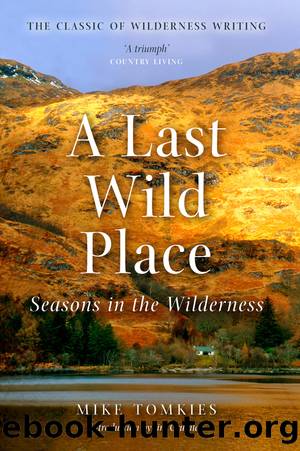A Last Wild Place by Mike Tomkies

Author:Mike Tomkies
Language: eng
Format: epub
Publisher: Jonathan Cape
Chapter 12
The Woodlands in Autumn
As autumn approaches, the sun sinking imperceptibly lower each day, the warm air rises from the summer-heated land, cold air rushes in to replace it, and the first real gales begin. In mid-September there comes a chill to the air and the winds blow the first leaves from the alders along the shore; a few hazel and rowan leaves are next and their nuts and scarlet berries begin to fall. One day whole twigs with leaves are torn from the oldest ashes and then, towards the end of the month, the first hailstorms from the north sweep the hills and woods, physically dislodging leaves, nuts and berries from the trees.
But summer is not yet done and early October stages short revivals when the gloom clouds roll away, and for a few days the sun burns from skies at their deepest blue. As I hasten to collect more dry dead logs for winter firewood, the woods are again filled with bird song â great tits chinking, chaffinches chipping, wrens firing staccato salvos, robins tipping silver coins on to a tray, and even tree creepers adding their thin squeaky voices to the choir. In the canopy long tailed tits are forming the first winter flocks with coal tits, their shrill cries mingling with the zinging of goldcrests. As I lie in the sun for an hour or so of healthy rays, the air free at last from summerâs bothersome midges, it seems the birds are no longer singing merely to advertise their presence to mates or rivals, or to defend or re-establish territories. Their breeding season is over â no nests, no wives, no territories really now â and they appear to be singing for sheer joy in the last of the warm sunshine, as if to recall the rapture of spring.
Soon these halcyon days are over, the cold winds, rain and hail return, darkness advances to later in the morning, comes earlier each afternoon, sap-making decreases in the chilled trunks, before the most spectacular scene change of the woodland theatreâs entire year. Slowly, just one or two leaves at first, the trees change colour. The witch brooms of rowans turn orange, then crimson and then dark red. The hazel leaves go yellow and then become tipped with orange. The ashes pass from dark to light green, then turn fiery yellow and one October day when I come up the loch in the boat the oldest ash, the first to go, will look like a fire behind the cottage. The larch needles change from light green to deep gamboge and fall driftingly in the breezes like dry rain, each tree an individual pillar of fire springing from the ground. The jade tips of the birches turn golden and begin to fall, but the oaks and beeches hold out the longest, until the stronger November storms. Then the dark oak leaves turn slowly sere, to the khaki of their childhood and then to russet; while the beeches slowly change to orange and finally to a deep ruddy brown.
Download
This site does not store any files on its server. We only index and link to content provided by other sites. Please contact the content providers to delete copyright contents if any and email us, we'll remove relevant links or contents immediately.
Man-made Catastrophes and Risk Information Concealment by Dmitry Chernov & Didier Sornette(4731)
The Revenge of Geography: What the Map Tells Us About Coming Conflicts and the Battle Against Fate by Kaplan Robert D(3596)
Zero Waste Home by Bea Johnson(3286)
COSMOS by Carl Sagan(2944)
In a Sunburned Country by Bill Bryson(2942)
Good by S. Walden(2910)
The Fate of Rome: Climate, Disease, and the End of an Empire (The Princeton History of the Ancient World) by Kyle Harper(2431)
Camino Island by John Grisham(2380)
A Wilder Time by William E. Glassley(2358)
Organic Mushroom Farming and Mycoremediation by Tradd Cotter(2304)
Human Dynamics Research in Smart and Connected Communities by Shih-Lung Shaw & Daniel Sui(2175)
The Ogre by Doug Scott(2105)
Energy Myths and Realities by Vaclav Smil(2054)
The Traveler's Gift by Andy Andrews(2008)
Inside the Middle East by Avi Melamed(1937)
Birds of New Guinea by Pratt Thane K.; Beehler Bruce M.; Anderton John C(1905)
Ultimate Navigation Manual by Lyle Brotherton(1764)
A History of Warfare by John Keegan(1712)
And the Band Played On by Randy Shilts(1612)
